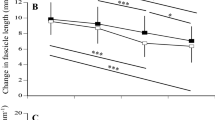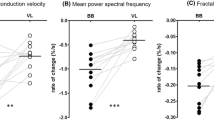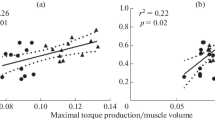Summary
To investigate the influence of skeletal muscle fiber composition on the mechanical performance of human skeletal muscle under dynamic conditions, 34 physical education students with differing muscle fiber composition (M. vastus lateralis) were used as subjects to perform maximal vertical jumps on the force-platform. Two kinds of jumps were performed: one from a static starting position (SJ), the other with a preliminary counter-movement (CMJ). The calculated mechanical parameters included height of rise of center of gravity (h), average force (¯F), net impulse (NI) and average mechanical power (W). It was observed that the percentage of fast twitch fibers was significantly related (p< 0.05-0.01) to these variables in SJ condition and also to h and NI of the positive work phase in CMJ. It is concluded that skeletal muscle fiber composition also determines performance in a multijoint movement. The result is explainable through the differences in the mechanical characteristics of the motor units and their respective muscle fibers.
Similar content being viewed by others
References
Alexander, R. McN., Bennet-Clark, H. C.: Storage of elastic strain energy in muscle and other tissues. Nature 265, 114–117 (1977)
Asmussen, E., Bonde-Petersen, F.: Storage of elastic energy in skeletal muscle in man. Acta Physiol. Scand. 91, 358–392 (1974)
Bárány, M.: ATPase activity of myosin correlated with speed of muscle shortening. J. Gen. Physiol. 50, 197–216 (1967)
Bergström, J.: Muscle electrolytes in man. Scand. J. Clin. Lab. Invest. (Suppl.) 68 (1962)
Brody, I. A.: Regulation of isometric contraction in skeletal muscle. Exp. Neurol. 50, 673–683 (1976)
Buchtal, F., Schmalbruch, H.: Contraction times and fibre types in intact human muscle. Acta Physiol. Scand. 79, 435–452 (1970)
Cavagna, G. A., Dusman, B., Margaria, R.: Positive work done by the previously stretched muscle. J. Appl. Physiol. 24, 21–32 (1968)
Cavagna, G. A., Komarek, L., Citterio, G., Margaria, R.: Power output of the previously stretched muscle. In: Medicine and sport, Vol. 6: Biomechanics II (Vredenbregt, J., Wartenweiler, J., eds.), pp. 159–167. Basel: Karger 1971
Close, R.: The pattern of activation in the sartorius muscle of the frog. J. Gen. Physiol. 46, 1–18 (1962)
Close, R.: Dynamic properties of fast and slow skeletal muscles of the rat during development. J. Physiol. (Lond.) 173, 74–95 (1964)
Gollnick, P. D., Armstrong, R. B., Saubert IV, C. W., Piehl, K., Saltin, B.: Enzyme activity and fiber composition in skeletal muscle of untrained and trained men. J. Appl. Physiol. 33, 312–319 (1972)
Gydikov, A. G., Dimitrov, G., Kosarov, D., Dimitrova, N.: Functional differentiation of motor units in human opponens pollicis muscle. Exp. Neurol. 50, 36–47 (1976)
Hill, D. K.: Tension due to interaction between the sliding filaments in resting striated muscle, the effect of stimulation. J. Physiol. (Lond.) 199, 637–684 (1968)
Huxley, A. F., Simmons, R. M.: Mechanical properties of the cross-bridges of frog striated muscle. J. Physiol. (Lond.) 134, 527–530 (1971)
Komi, P. V., Viitasalo, J. H. T., Havu, M., Thorstensson, A., Sjödin, B., Karlsson, J.: Skeletal muscle fibres and muscle enzyme activities in monozygous and dizygous twins of both sexes. Acta Physiol. Scand. 100, 385–392 (1977)
Komi, P. V., Bosco, C.: Utilization of stored elastic energy in men and women. Med. Sci. Sports 10, 261–265 (1978)
Padykula, R., Herman, E.: The specificity of the histochemical method of adenosine triphosphatase. J. Histochem. Cytochem. 3, 170–195 (1955)
Rack, P. M. H., Westerbury, D. R.: The short range stiffness of active mammalian muscle and its effect on mechanical properties. J. Physiol. (Lond.) 240, 331–350 (1974)
Rusko, H., Havu, M., Karvinen, E.: Aerobic performance capacity in athletes. Eur. J. Appl. Physiol. 38, 151–159 (1978)
Steg, G.: Efferent muscle innervation and rigidity. Acta Physiol. Scand. 61 (Suppl.), 225 (1964)
Thorstensson, A., Grimby, G., Karlsson, J.: Force-velocity relations and fiber composition in human knee extensor muscles. J. Appl. Physiol. 40, 12–16 (1976)
Thorstensson, A., Karlsson, J.: Fatiguability and fibre composition of human skeletal muscle. Acta Physiol. Scand. 98, 318–322 (1976)
Viitasalo, J. T., Komi, P. V.: Force-time characteristics and fibre composition in human leg extensor muscles. Eur. J. Appl. Physiol. 40, 7–15 (1978)
Author information
Authors and Affiliations
Rights and permissions
About this article
Cite this article
Bosco, C., Komi, P.V. Mechanical characteristics and fiber composition of human leg extensor muscles. Europ. J. Appl. Physiol. 41, 275–284 (1979). https://doi.org/10.1007/BF00429744
Accepted:
Issue Date:
DOI: https://doi.org/10.1007/BF00429744




